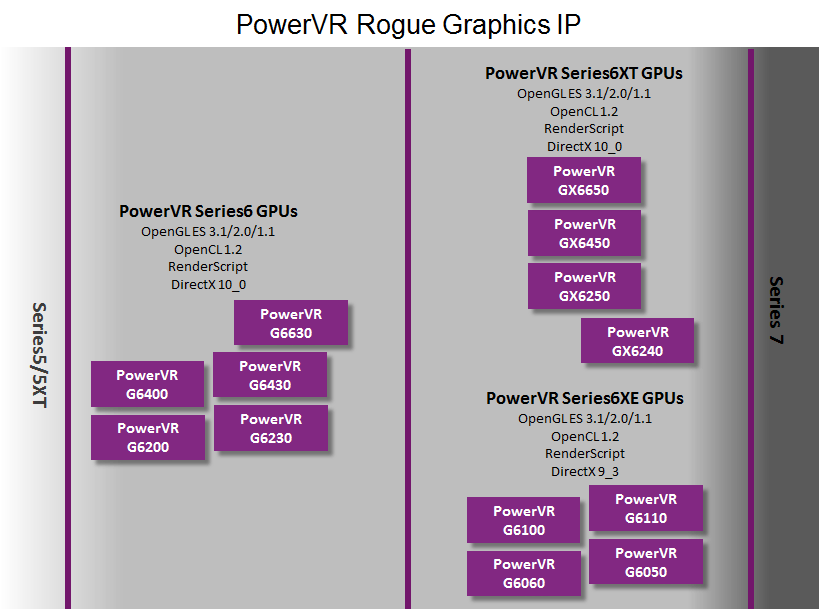- 17 July 2014
- Imagination Technologies
While writing the conclusion for the article announcing OpenGL® ES 3.1 conformance for PowerVR Rogue GPUs, I suddenly realized that we now have more than ten apps processors using PowerVR Rogue GPUs; this includes various configurations of dual or quad-cluster PowerVR Series6 graphics processors.
Therefore, I came up with this idea of offering a bite-sized blog post that summarizes our current line-up of GPUs. You can use the menu below to navigate between our GPU families:
This article is meant to offer you a comprehensive look at the specifications, features and API support for the PowerVR Rogue family. I highly recommend you add it to your bookmarks and come back from time to time because I will continue updating it when we announce next-generation GPUs.
If you want a better understanding of the internal architecture of the USC (Unified Shading Cluster), please read Rys’s expose (Graphics cores: trying to compare apples to apples) and check out Imagination’s PowerVR Rogue Architecture Explored (lots of diagrams included), an in-depth review from Ryan Smith at Anandtech.
For those of you who want to query this information in code, Joe Davis from our Developer Support team has uploaded a C++ helper function to GitHub that takes a PowerVR Rogue model number string as input (e.g. an OpenGL ES GL_RENDERER string) and outputs a structure of basic hardware capabilities. Try it out on a mobile device that has a PowerVR GPU and let us know what you think we should add or improve.
In summary, our PowerVR Rogue graphics architecture brings a number of unique features designed to improve overall system performance, lower power consumption and reduce memory bandwidth:
- Scalar processing to achieve the highest utilization of ALUs and ease graphics programming
- PVR3C™ triple compression: a combination of lossy texture compression (PVRTC and ASTC), lossless image compression (PVRIC) and lossless geometry compression (PVRGC) techniques to reduce memory bandwidth
- PowerGearing™ to manage different power consumption levels and balance overall SoC power consumption
- A mix of FP32 and FP16 ALUs for high-precision/low-power computing.
There are currently three families of GPUs based on the PowerVR Rogue architecture (see the roadmap below); the tables that follow describe how the features above map to each GPU.
PowerVR Series6XT GPUs: ultra-high performance, ultimate feature set
Introduced at CES 2014: blog article
| PowerVR GPU | No. of USCs | No. of ALUs | Texture compression | Frame buffer compression | Geometry compression |
| GX6240 | 2 | 64 (FP32) 128 (FP16) |
PVRTC1/2 ETC1/2 BC1/2/3 |
– | PVRGC |
| GX6250 | 2 | 64 (FP32) 128 (FP16) |
PVRTC1/2 ASTC (LDR + HDR) ETC1/2 BC1/2/3 |
PVRIC2 | PVRGC |
| GX6450 | 4 | 128 (FP32) 256 (FP16) |
PVRTC1/2 ASTC (LDR + HDR) ETC1/2 BC1/2/3 |
PVRIC2 | PVRGC |
| GX6650 | 6 | 192 (FP32) 384 (FP16) |
PVRTC1/2 ASTC (LDR + HDR) ETC1/2 BC1/2/3 |
PVRIC2 | PVRGC |
API support*: OpenGL ES 1.1/2.0/3.1, OpenGL 3.3, OpenCL 1.2 EP, RenderScript, DirectX 10_0
PowerVR Series6 GPUs: performance efficiency and a balanced feature set
Introduced at CES 2012:
| PowerVR GPU | No. of USCs | No. of ALUs | Texture compression | Frame buffer compression | Geometry compression |
| G6200 | 2 | 64 (FP32) | PVRTC1/2 ETC1/2 BC1/2/3 |
– | PVRGC |
| G6230 | 2 | 64 (FP32) 96 (FP16) |
PVRTC1/2 ETC1/2 BC1/2/3 |
PVRIC | PVRGC |
| G6400 | 4 | 128 (FP32) | PVRTC1/2 ETC1/2 BC1/2/3 |
– | PVRGC |
| G6430 | 4 | 128 (FP32) 192 (FP16) |
PVRTC1/2 ETC1/2 BC1/2/3 |
PVRIC | PVRGC |
| G6630 | 6 | 192 (FP32) 288 (FP16) |
PVRTC1/2 ETC1/2 BC1/2/3 |
PVRIC | PVRGC |
API support: OpenGL ES 1.1/2.0/3.1, OpenGL 3.3, OpenCL 1.2 EP, RenderScript, DirectX 10_0
PowerVR Series6XE GPUs: OpenGL ES 3.1 for everyone!
Introduced at CES 2014: blog article
| PowerVR GPU | No. of USCs | No. of ALUs | Texture compression | Frame buffer compression | Geometry compression |
| G6050 | 1/2 | 16 (FP32) 32 (FP16) |
PVRTC1/2 ETC1/2 BC1/2/3 |
– | – |
| G6060 | 1/2 | 16 (FP32) 32 (FP16) |
PVRTC1/2 ETC1/2 BC1/2/3 |
PVRIC2 | – |
| G6100 | 1 | 32 (FP32) 64 (FP16) |
PVRTC1/2 ETC1/2 BC1/2/3 |
– | PVRGC |
| G6110 | 1 | 32 (FP32) 64 (FP16) |
PVRTC1/2 ETC1/2 BC1/2/3 |
PVRIC2 | PVRGC |
API support*: OpenGL ES 1.1/2.0/3.1, OpenGL 3.2, OpenCL 1.2 EP, RenderScript, DirectX 9_3
PowerVR Wizard ray tracing GPUs: interactive cinematic realism for mainstream devices
Introduced at GDC 2014:
| PowerVR GPU | No. of USCs | No. of ALUs | Texture compression | Frame buffer compression | Geometry compression | Ray tracing performance at 600 MHz |
| GR6500 | 4 | 128 (FP32) 256 (FP16) |
PVRTC1/2 ASTC ETC1/2 BC1/2/3 |
PVRIC2 | PVRGC | 300 million rays per second 24 billion node tests per second 100 million dynamic triangles per second |
API support*: OpenGL ES 1.1/2.0/3.1, OpenGL 3.3, OpenCL 1.2 EP, OpenRL 1.x, RenderScript, DirectX 9_3
I hope that this article provides a useful overview of our PowerVR Rogue GPUs. If you have any questions, please don’t hesitate to use the comment section below.
For the latest news and announcements on PowerVR graphics, GPU compute and ray tracing, follow us on Twitter (@ImaginationTech) and keep coming back to the blog.
Editor’s Note
* All PowerVR Rogue GPUs are based on published Khronos specifications and are expected to pass the Khronos Conformance Testing Process. PowerVR Series6 GPUs have already passed the Khronos Conformance Testing Process. Current conformance status can be found at www.khronos.org/conformance.
OpenGL is a registered trademark and the OpenGL ES logo is a trademark of Silicon Graphics Inc. used by permission by Khronos.
OpenCL and the OpenCL logo are trademarks of Apple Inc. used by permission by Khronos.







